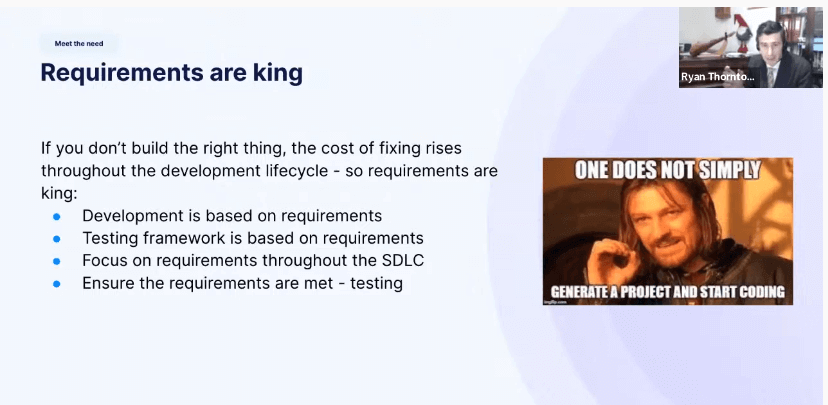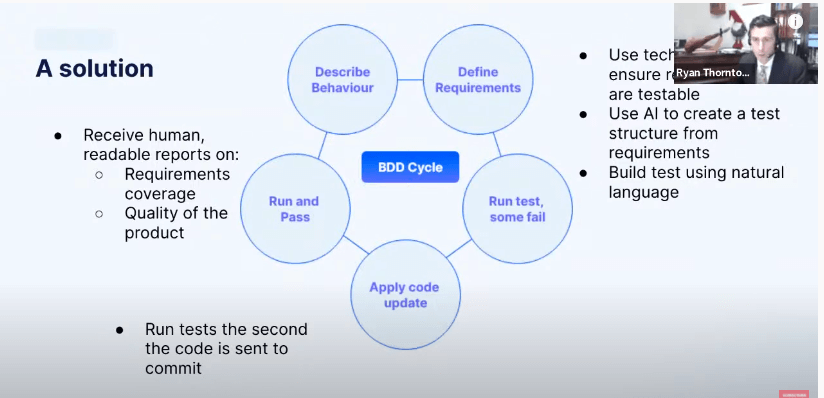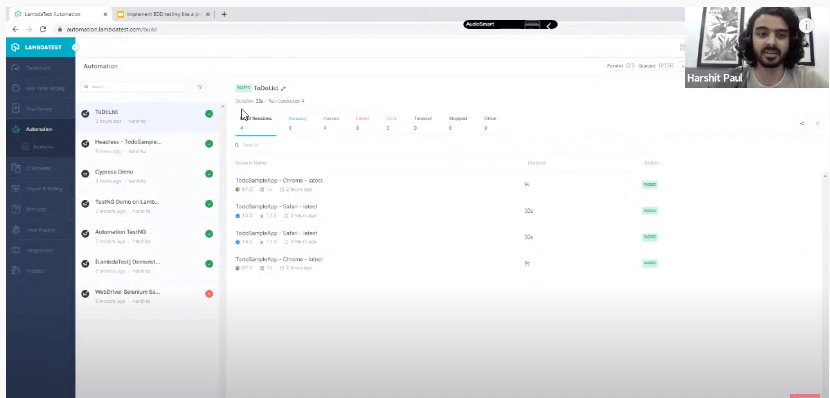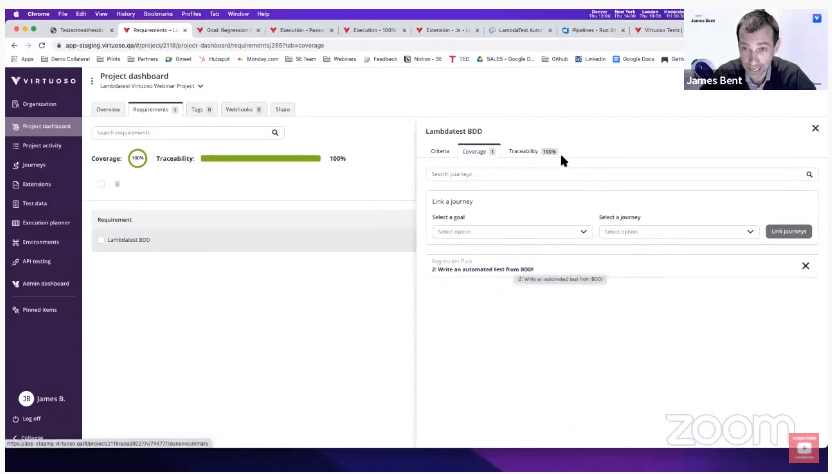Webinar: Implement BDD Testing Like A Pro For Quality Test Automation
Let’s start with a story. Immediately before I started my career in test automation, I was a stay-at-home dad, or the “hausfrau,” as I always put it to my German-speaking wife.
At some point, my wife said it was time for me to say goodbye to the yoga moms, leave the coffee mornings behind me, and re-enter the world of work. I was lucky enough to get a job in the test automation industry and spent a lot of my time editing blogs and other content authored by thought leaders in the industry. It struck me very quickly that when these thought leaders spoke about managing teams and implementing methodologies, the things they said were not entirely different from the conversation the yoga moms and I would have.
In fact, they were pretty much identical. All you had to do was supplement the word “children” for “team,” and voilà, you had a thought leadership blog on managing an agile team: speak the language they understand, ensure they have understood you, and make sure you constantly communicate and get fast feedback of understanding. The point of my story is that what lies herein is an oversimplification, and I make no apologies for it.
In this webinar, we take a look at Behaviour-Driven Development (BDD) with a broad-brush and see how new technologies are making adoption both easier and more attractive than ever.
What is BDD?
When trying to understand what BDD is, it might be nice to start with a quote, and if you can get a quote from its inventor, all the better. Quote time:
“It’s using examples to talk through how an application behaves… And having conversations about those examples.” – Dan North, originator of BDD
So, relatively simple then. Well, you would think so, but just like explaining to my two children how they should behave on a slide, it does not always work out so simply. Let’s take a step back and look at an example of the problem we are trying to overcome with this approach. We have our business bot here. He has a cracker of an idea: he’s going to change the world. He’s done his maths, the market is big, there is a need, next stop: millionaire’s row. There is just one tiny problem… He has no idea how to code. Step up software engineer bot, it’s her time to shine. The issue is they don’t speak the exact same language.
The business bot may ask for?? But Software engineer bot interprets this as?? And confusion rains.
Also Read: TDD vs. BDD: Choosing The Right Framework
A bit more detail
BDD attempts to overcome any confusion with a few simple rules:
- Promote communication between the business interests, developers, and testers. These three interests/groups/people are represented as the three amigos.
- Shared process and shared tools. This can be problematic as many tools require engineering skills, meaning two of the amigos can heavily rely on the other. This can explain why BDD adoption is often sporadic and does not encompass the entire Software Delivery Lifecycle (SDLC).
- Establish what the system should and should not do.
- Provide better readability and visibility.
- Don’t just build it the right way – build the right thing.
The final point is worth a little more discussion. Let’s pretend it is entirely possible that you built a completely bug-free piece of software. Developers and testers would be giving themselves a pat on the back. But it would be a hollow victory if they hadn’t built what the business wanted them to. Or to further murder the childcare metaphor, “Dad, I behaved perfectly on the swings!” “Yes you did son, but I asked you to play on the slide.”
Read More – All You Need To Know About Automation Testing Life Cycle
Requirements are king
As anyone who has taken even the briefest of glances at the wealth of content on test automation knows, the cost of fixing a bug increases throughout the SDLC. The same is true if you build the wrong thing. For this reason, requirements are king. When written well, they ensure that developers know what to deliver and that the software can be tested against the requirements. Two problem areas can be seen here:
- Writing requirements that are testable is not easy, and the fact that testing often happens at the end of the SDLC means you may find out that your requirements are not testable or just wrong after the application has been built.
- Tools for monitoring requirements across the SDLC have been developer-driven, giving limited visibility to the other two amigos.
- Requirement management can mislead teams into waterfall development by incentivizing long planning intervals and large delivery units.
Requirements can be written as a series of specifications that follow a similar structure. This is often called Gherkin Syntax and describes how an application should behave using the given, then, when format.
Read More – Behaviour Driven Development By Selenium Testing With Gherkin
BDD cycle and where it can fail
The BDD cycle works something like this:
- Describe behavior
- Define requirements
- Run tests
- Apply any code update
- Get the tests to pass
- Start again
There are, at least, two key areas that can be problematic when trying to adopt the methodology throughout the SDLC:
- Tests cannot be authored before the app is created, making testing a bottleneck and understanding if you are building the right thing problematic
- Tools often require engineering skills.
Also, Read – 17 Skills Of Highly Effective Software Testers
Challenges revolving around test automation
An agile development process requires automation testing. It entails developing an individual software framework to automate testing of the primary solution. The testing framework becomes more intricate as the solution becomes more complex. When you reach the point where every release involves executing hundreds of test cases and actions, automation testing becomes crucial.
Below are the major challenges faced by testers in test automation:
- Automation testing is difficult to implement because of a lack of top-notch features that allow the tool to deal with variations in the application under test.
- The test data and the environment’s availability and stability pose a challenge. This is because there aren’t enough supported environments for testers to examine the application under test across numerous browsers and platforms.
- Even though automation is not a new concept, QA professionals’ skill set is sometimes insufficient to implement an automation project completely. It is one of the most common roadblocks that beginners to test automation face.
Read – Top 13 Challenges Faced In Agile Testing By Every Tester
However, cloud-based platforms like LambdaTest help you bridge that gap and let you leverage the true potential of automation testing. Integrating Virtuoso with LambdaTest allows you to perform codeless automation testing at scale to ensure your web app works flawlessly across every browser and OS combination.
LambdaTest – A Swiss Knife for developers & testers
Manual cross browser testing is impractical with several browsers, operating systems, and devices on the market today. In addition, covering such a vast combo manually can be cumbersome. As a result, automated cross browser testing is critical for any organization that wants its applications to perform seamlessly across multiple platforms and device combinations. This is where automation testing platforms come into the picture.
Automation testing platforms like LambdaTest enable you to test your website across 3000+ browsers and browser versions without the hassle of setting up an in-house device lab. With its cloud-based Selenium grid, you don’t have to worry about maintaining lofty device labs.
Shown below are some of the top-notch features of LambdaTest:
- Extend your cloud-based test environments by running Selenium automated testing directly from Virtuoso instances.
- Use Virtuoso or LambdaTest to run parallel tests and view test reports.
- You can analyze and extract Selenium test reports.
- Integrate tests with the best CI/CD tools in the market.
- Error detection and annotation.
- You can also view detailed test logs, test analytics, and much more.
Codeless testing with LambdaTest & Virtuoso
Recent advances in Machine Learning, other forms of AI, and Natural Language Processing mean that implementing BDD across the SDLC has never been easier. Hyper automated testing tools like Virtuoso allow anyone to import requirements and automatically create a test structure as well as create fully executable functional and end-2-end tests. Which is a pretty big shift left. Now you can combine these capabilities with LambdaTest – a cross browser testing platform.
And as there is no coding at any stage, everything is documented in human-readable language and visible to all three amigos. With LambdaTest and Virtuoso integration, you can execute tests on any device the second the code has been sent to commit. Integrating Virtuoso with LambdaTest will help perform end-to-end codeless testing using Selenium with BDD framework while expanding your browser and device test coverage, ensuring a flawless user experience for your website users.
Q&A Session
Before we close up, here’s a quick overview of the Q&A session.
What types of testing does Virtuoso support?
James – Virtuoso offers browser-based testing that can be on both public and private networks. For private networks, you can use secure TLS tunnels in enterprise environments for end-to-end functional testing. We also have an API manager that lets you easily build APIs and embed those into your functional tests. Besides, we also support visual regression testing for web applications.
Can we use background scripts to extend the QE experience?
James – Yes! In Virtuoso, we’re trying to enable the majority of testing to be done with natural language. We enable you to extend Virtuoso with little JavaScripts that you can build into Virtuoso and then execute as part of your test. It could be JavaScript expressions, an expression to create a date that you’re going to use in your tests, or it could be to actually perform a function including taking variables that you map into that or export from that.
If the requirements are constantly changing, does adding more BDD files will update data scripts automatically?
James – Changing BDDs and requirements means there are new developments you can certainly leverage portions of the test. For example, you could say my first part, my login stayed the same, and then it’s the second part, so you could reuse and embed the BDDs just for the change part. It’s quick and easy to rewrite them at this stage, but of course, we’re just continually developing, so as we find that method to standardize and update, you’ll be sure we’ll be putting it in.
Watch the on-demand webinar to see how easy BDD adoption has become a reality. Now, if someone can tell me how to stop the kids from fighting, all would be good.
Published on Java Code Geeks with permission by Salman Khan, partner at our JCG program. See the original article here: Webinar: Implement BDD Testing Like A Pro For Quality Test Automation Opinions expressed by Java Code Geeks contributors are their own. |











Most people can develop health problems when they are under a lot of stress. People often suffer from problems in sexual captivity. I can recommend you a remedy by clicking on this link to learn more , which saved me from this disease. I order it from an online pharmacy without a prescription at a very affordable price.